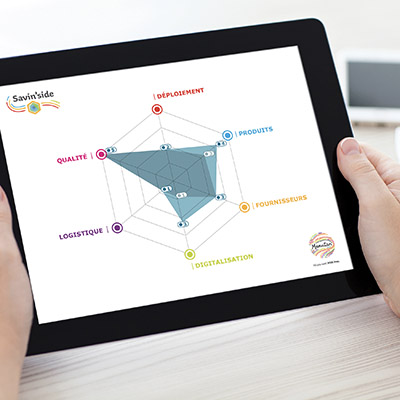In the face of climate change, many businesses are progressively committing to reduce their carbon footprint. In this dynamic, the GHG Protocol (Greenhouse Gas Protocol) presents itself as an essential tool to help companies measure, monitor and reduce their greenhouse gas emissions. This also applies to the procurement function, which has a major role to play in the decarbonation of every product life cycle (from its development to its end-of-life).
What is the GHG Protocol?
The Greenhouse Gas Protocol, or GHG Protocol, proposes an international framework for measuring greenhouse gas emissions and setting reduction targets. This includes a whole series of continuously updated standards and tools for determining greenhouse gas emissions from the operations of the private and public sectors, as well as their value chains. All of these norms take into account the six greenhouse gases covered by the Kyoto Protocol.
-
Carbon dioxide (CO2);
-
Methane (CH4);
-
Hydrofluorocarbons (HFCs);
-
Nitrous oxide or nitric oxide (N2O);
-
Perfluorocarbons (PFCs);
-
Sulfur hexafluoride (SF6).
The GHG Protocol was developed in the late 1990s by the World Resources Institute (WRI) and the World Business Council for Sustainable Development (WBCSD). Subsequently, the international standard ISO 14064, relating to measuring and reporting greenhouse gas emissions, was created, based on this international protocol.
To date, the GHG Protocol is the most widely known carbon accounting framework worldwide. In 2016, 92% of companies from the Fortune 500 ranking had directly or indirectly used this tool to publish their carbon footprint via the CDP (Carbon Disclosure Project)[1].
Within companies, two standards developed by the GHG Protocol are mainly used. These are the "Corporate Standard", which provides requirements and guidance for organisations planning to conduct a greenhouse gas emissions inventory. The second, the "Corporate Value Chain Standard", helps them assess the impact of their entire value chain (scope 3 emissions) and where to focus their actions to reduce GHG emissions.
-
Scope 1 refers to all direct emissions from sources owned or controlled by the company, such as facilities and vehicles.
-
Scope 2 covers indirect emissions related to the heat, electricity or cooling consumption by the company.
-
Scope 3 concerns other indirect emissions from the company's activities, but which are outside its operational perimeter, such as emissions related to the purchase of goods and services.
The 5 Core Principles of the GHG Protocol Corporate Standard
According to the GHG Protocol standards, any method of greenhouse gas accounting and reporting in a company must be based on five major principles.
Relevance
This involves defining the perimeters that truly reflect an organisation's GHG emissions. This depends on the characteristics of the company, the objective of the approach, and the needs of users.
Completeness
This implies considering all activities and sources of GHG emissions within the chosen organisational and operational boundaries. It is important to indicate any omissions and justify them.
Consistency
The idea is to be able to compare the evolution of greenhouse gas emissions over time. Thus, any methodological change must be indicated to ensure the validity of comparisons.
Transparency
It is important to ensure the reliability of the reported information. To do this, it is necessary to address any subject in a factual, consistent and verifiable manner. The fundamental options and methods used to calculate emissions should also be shared.
Accuracy
Lastly, it is necessary to ensure that the measurement of greenhouse gas emissions is sufficiently accurate for its intended use in order to guarantee the integrity of public information in this area.
The objectives of the GHG Protocol
The GHG Protocol is an essential tool for any organisation seeking to measure and manage greenhouse gas (GHG) emissions from its activities effectively.
A simplified approach
Companies will be able to reduce the time and expenses required to develop greenhouse gas emissions accounting and reporting systems thanks to the standards and other resources (guides, tools and training) provided by the GHG Protocol. This also allows employees to be trained on these topics, to understand the issues related to their missions and, thus, to make informed decisions.
Strategic information
Companies must accurately account for greenhouse gas emissions in order to develop solid reduction strategies and engage the right levers. It also allows them to participate in emissions trading markets.
A common standard
Lastly, companies have every interest in conducting their greenhouse gas inventories in compliance with current and future requirements and standards. To date, the GHG Protocol is compatible with most reporting requirements, whether voluntary or mandatory. By relying on a standard as recognised as the GHG Protocol, this fosters comparability, credibility, and usefulness of information.
Ultimately, it is a great way for companies to increase their transparency, reduce their risks and gain a competitive advantage over their stakeholders' expectations for sustainable development.
The GHG Protocol proves to be an indispensable tool for companies wishing to embark on a credible and operational net zero trajectory. By better understanding and managing greenhouse gas emissions, they can concretely act in favour of the decarbonation of their activities, but also of their entire value chain. In this dynamic, the procurement function also has a key role to play in engaging partner suppliers in the transition towards a more sustainable future. And for good reason! Let us not forget that supply chains account for about 60% of global emissions and 80% of the carbon footprint of an average company[2]. This reminds us that the fight against climate disruption remains collective.









